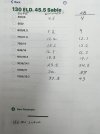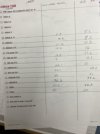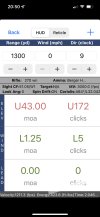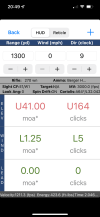Read on
You are using an out of date browser. It may not display this or other websites correctly.
You should upgrade or use an alternative browser.
You should upgrade or use an alternative browser.
Shooting Apps why aren't they more accrete?
- Thread starter RockyRandy
- Start date
 Help Support Long Range Hunting Forum
Help Support Long Range Hunting Forum
3 to 4 years ago if you would of said what you said about my ability to shoot accurately I would of been offended but now that I have gotten into long range shooting and have shot 1500+ rounds I have found out just how crappy of a shot I use to be. But now I'm ok with it! I have since read most of litz 3 books, Also Ryan Clecken Book. Went to a long range training in Utah last year and in the process of take a online training form Jamie Dodson of Wolf precision as we speak. And I'm far from perfect or where i want to be and that's why I'm asking the questions I'm asking. I will say that i can run through my range which I have posted here and hit all the targets without a problem + or - wind. I will admit i need to focus on bring those group sizes down. I agree with you Quicksilver on having to many apps and not knowing them well enough, but back to my post in the first place that I have yet to find one that works closely with my DOPE. DOPE being, I hit the target at the given range! Maybe mine aren't 1/10th of a mil. Rad apart at a 1000 yards like dfanonymous are but I do hit the target. I will take the time to get my Transonic and subsonic worked out which I know will help with my Kestral.
Attachments
Last edited:
Quicksilver338
Well-Known Member
What is the ES of your loads? Would hate for you to be chasing something if all it was was a velocity discrepancy.
Doom2
Well-Known Member
Beyond 500-600 yds the ballistic coefficient variation has a significant effect on the ballistics while below 300yds it has almost zero effect that is measurable. At distance we assume that the temperature is the same as at the firing point. We assume wind is only in the horizontal plane when it is often also vertical depending on terrain. We use a program that assumes a point mass for the bullet when in reality it's not. Coriolis effect may or may not be in the calculator assumptions and spin drift may or may not be included and is only an estimate. The ballistic coefficient model probably doesn't correspond to the actual shape of projectile in flight. If a G1 is used for a boat tail it will be in error in the trans sonic zone.
I could keep going but the fact is that all ballistic calculators should be considered estimators. Small errors accumulate as the bullet travels. Errors in input data accumulate.
I could keep going but the fact is that all ballistic calculators should be considered estimators. Small errors accumulate as the bullet travels. Errors in input data accumulate.
LaHunter
Well-Known Member
Reading this made me think of 'what powders'? Some powders can give a significant mv variation with ambient temp changes.What is the ES of your loads? Would hate for you to be chasing something if all it was was a velocity discrepancy.
Thanks for getting back, The whole point im trying to get at is this, At my local shoots that I go to have different range for the target that I am shooting and i range with my range finder which is a revic br4 and tells me what to dial for. The range that I have given you are the ones I know I can hit at but when it tells me to set at 15 moa up and it is really 18 and i hit in front of the target it does fair very well on my score.
Hugnot
Well-Known Member
The ap math provides an estimate and different aps can have different math procedures. As the bullet plows thru an ocean of air all sorts of stuff can affect its flight and any ap that accepts set bullet form specs & set environmental condition data would perform a robotic ballistic solution that would not compensate for unknown or changing conditions - no pilot on board, no fins, no rockets, no remote guidance features.
True but shooting both loads with same powder and the 136 bullet hit spot on with chart & the130grn bullet shoots low at close range and high at long range. I've had the same problem with H4350 H4831 Varget.Reading this made me think of 'what powders'? Some powders can give a significant mv variation with ambient temp changes.
Right now I'm using Gunwerks Revic app. I have the new BR4 range finder. It pulls up targets out pass 1500 yardsAre you using your Kestrel or one of the free phone apps?
dfanonymous
Well-Known Member
- Joined
- Jul 16, 2016
- Messages
- 2,018
Being a tenth of a mil (.1) off can be tremendous. For visualization, at 1000y that's 3.6 inches. Not the end of the world. But on a 12 inch target which is a hair over moa, and a realistic vital zone, being .1 mil off gives you about a 2/3 hit probability assuming all else is perfect. Having a 3/4 chances would be better and ideally 7/8ths would be operating with about as perfect as you can ask for in probability.3 to 4 years ago if you would of said what you said about my ability to shoot accurately I would of been offended but now that I have gotten into long range shooting and have shot 1500+ rounds I have found out just how crappy of a shot I use to be. But now I'm ok with it! I have since read most of litz 3 books, Also Ryan Clecken Book. Went to a long range training in Utah last year and in the process of take an online training form Jamie Dodson of Wolf precision as we speak. And I'm far from perfect or where i want to be and that's why I'm asking the questions I'm asking. I will say that i can run through my range which I have posted here and hit all the targets without a problem + or - wind. I will admit i need to focus on bring those group sizes down. I agree with you Quicksilver on having to many apps and not knowing them well enough, but back to my post in the first place that I have yet to find one that works closely with my DOPE. DOPE being, I hit the target at the given range! Maybe mine aren't 1/10th of a mil. Rad apart at a 1000 yards like dfanonymous are but I do hit the target. I will take the time to get my Transonic and subsonic worked out which I know will help with my Kestral.
All your problems are in this post I would suspect.
By far, objectively, it's not a comparison…Applied Ballistics makes the most solid ballistic solver, bar none. It's good enough for the military and the .gov, it's good enough for people here. The staff hold records.
It's not a "estimator" as others have suggested. The numbers need to be trued. Your true dope that you actually hit needs to be consistent. A lot of guys think because they are getting hits that that's it, but the second you change shooting positions, it changes again, and then you're chasing numbers.
This goes back to fundamentals.
If true data numbers are solid, you should be able to reverse the numbers on any ballistic solver until the data lines up. Unfortunately because of influences that we the shooters impart on the rifle, scope tracking errors, range finder tolerance errors and a series of other rounding errors, like cooking your ammo in hot chamber that compound, and again, your further dope will rarely if ever line up.
A problem I can already see comparing your true dope to a solver is that your MV is not correct in the ballistic solver. The MV isn't correct despite using an expensive chrono because of those other compounding errors I was talking about, a bad zero or inconsistency/bad technique is being averaged into the data. The bullet doesn't lie, and the math is just…math. If it doesn't add up, then something is not being accounted for correctly.
You'd have to verify the numbers (drop) at a range, say, 600y…well into supersonic but far enough to have measurable results. Then make sure that the MV will give you data numbers that reflect reality. Then at transonic you can fudge BC's or drop scale factor if you use AB. That is assuming. Equipment is all good, tall target test in done with a degree of accuracy, and the ammo AND shooter perform with a level of accuracy.
Overlooked data in ballistic calculators is sight scale vertical for scope tracking
Your scopes tracking error can be a big impact
Your scopes tracking error can be a big impact
Last edited:
HARPERC
Well-Known Member
I can't help, but point to the title. Shooting apps why aren't they more "ACCRETE"? Makes it hard to rule out input error.
Then again my typing skills, and declining visual acuity, make me an expert on bad inputs.
Then again my typing skills, and declining visual acuity, make me an expert on bad inputs.
Thanks for the break down and I will spend more time shooting and fine tuning my dope.Being a tenth of a mil (.1) off can be tremendous. For visualization, at 1000y that's 3.6 inches. Not the end of the world. But on a 12 inch target which is a hair over moa, and a realistic vital zone, being .1 mil off gives you about a 2/3 hit probability assuming all else is perfect. Having a 3/4 chances would be better and ideally 7/8ths would be operating with about as perfect as you can ask for in probability.
All your problems are in this post I would suspect.
By far, objectively, it's not a comparison…Applied Ballistics makes the most solid ballistic solver, bar none. It's good enough for the military and the .gov, it's good enough for people here. The staff hold records.
It's not a "estimator" as others have suggested. The numbers need to be trued. Your true dope that you actually hit needs to be consistent. A lot of guys think because they are getting hits that that's it, but the second you change shooting positions, it changes again, and then you're chasing numbers.
This goes back to fundamentals.
If true data numbers are solid, you should be able to reverse the numbers on any ballistic solver until the data lines up. Unfortunately because of influences that we the shooters impart on the rifle, scope tracking errors, range finder tolerance errors and a series of other rounding errors, like cooking your ammo in hot chamber that compound, and again, your further dope will rarely if ever line up.
A problem I can already see comparing your true dope to a solver is that your MV is not correct in the ballistic solver. The MV isn't correct despite using an expensive chrono because of those other compounding errors I was talking about, a bad zero or inconsistency/bad technique is being averaged into the data. The bullet doesn't lie, and the math is just…math. If it doesn't add up, then something is not being accounted for correctly.
You'd have to verify the numbers (drop) at a range, say, 600y…well into supersonic but far enough to have measurable results. Then make sure that the MV will give you data numbers that reflect reality. Then at transonic you can fudge BC's or drop scale factor if you use AB. That is assuming. Equipment is all good, tall target test in done with a degree of accuracy, and the ammo AND shooter perform with a level of accuracy.



